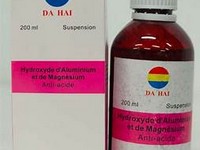Aluminium hydroxide
CLINICAL USE
DOSE IN NORMAL RENAL FUNCTION
PHARMACOKINETICS
78
70–90
No data
No data
No data
DOSE IN RENAL IMPAIRMENT
GFR (mL/MIN)
Dose as in normal renal function
DOSE IN PATIENTS UNDERGOING RENAL REPLACEMENT THERAPIES
Unknown dialysability. Dose as in
normal renal function
Unknown dialysability. Dose as in
normal renal function
Unknown dialysability. Dose as in
normal renal function
Unknown dialysability. Dose as in
normal renal function
IMPORTANT DRUG INTERACTIONS
Potentially hazardous interactions with other drugs
None known
ADMINISTRATION
Reconstition
–
Route
Oral
Rate of Administration
–
Comments
–
OTHER INFORMATION
aluminium toxicity; therefore best avoided
in all but short-term therapy (calcium
carbonate, calcium acetate, lanthanum or
sevelamer are used in chronic therapy)
aluminium levels should be monitored
